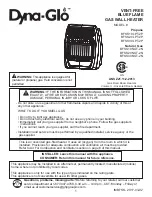
23
TROUBLESHOOTING GUIDE
Start Up Conditions
Thermal Expansion
Water supply system may, because of such events as high line
pressure, frequent cut-offs and the effects of water hammer have
installed devices such as pressure reducing valves, check valves,
back flow preventers, etc., to control these types of problems.
When these devices are not equipped with an internal by-pass,
and no other measures are taken, the devices cause the water
system to be closed. As water is heated, it expands (thermal
expansion) and closed systems do not allow for the expansion
of heated water.
The water within the water heater tank expands as it is heated and
increases the pressure of the water system. If the relieving point
of water heater’s temperature-pressure relief valve is reached,
the valve will relief the excess pressure.
The temperature-
pressure relief valve is not intended for the constant relief
of thermal expansion.
This is an unacceptable condition and
must be corrected.
It is recommended that any devices installed which could
create a closed system have a by-pass and/or the system have
an expansion tank or device to relieve the pressure built by
thermal expansion. Thermal expansion tanks are available from
Sears stores and through the Sears Service Centers. Contact
the local plumbing inspector, water supplier and/or the Sears
Service Center for assistance in controlling these situations,
see Figure 27.
Thermal Expansion Tank Specifications
Tank Dimensions
Pipe
Model
Capacity in Inches
Fitting
Number In Gallons Diameter
Length
On Tank
153.331020
2
8 (203 mm) 12-3/4 (323 mm) 3/4” Male
153.331050
5
11 (279 mm) 14-3/4 (375 mm) 3/4” Male
Expansion Tank Sizing Chart
Inlet* Water Heater Capacity (Gallons)
Water
Pressure 30
40
50
66 82
Expansion
40psi
2
2
2
5
5
Tank
50psi
2
2
2
5
5
Capacity
60psi
2
2
5
5
5
Needed
70psi
2
2
5
5
5
80psi
2
5
5
5
5
*Highest recorded inlet water pressure in a 24 hour period or
regulated water pressure.
NOTE: Expansion tanks are pre-charged with a 40 psi air
charge. If the inlet water pressure is higher than 40 psi, the
expansion tank’s air pressure must be adjusted to match
that pressure, but must not be higher than 80 psi.
FIGURE 27.
Strange Sounds
Possible noises due to expansion and contraction of some metal
parts during periods of heat-up and cool-down do not represent
harmful or dangerous conditions.
Condensation causes sizzling and popping within the burner area
during heating and cooling periods and should be considered
normal. See
Condensation
section.
Draft Hood Operation
Check draft hood operation by performing a worst case
depressurization of the building. With all doors and windows
closed, and with all air handling equipment and exhaust fans
operating such as furnaces, clothes dryers, range hoods and
bathroom fans, a match flame should still be drawn into the draft
hood of the water heater with its burner firing. If the flame is not
drawn toward the draft hood, shut off water heater and make
necessary air supply changes to correct.










































